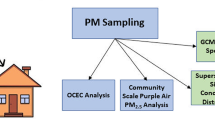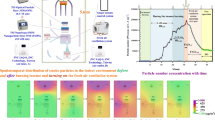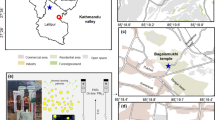Abstract
Residential areas are being increasingly impacted by wildfire smoke that causes hazardous local ambient air quality conditions. Poor outdoor air quality also exacerbates the quality of indoor air as smoke particles penetrate the building envelope or the heating, ventilation, and air-conditioning (HVAC) filtration systems. In this work, we investigate the impact of wildfire-affected poor ambient air quality on indoor air particulate matter during a wildfire episode in June 2015 in interior Alaska. We measured size-resolved (0.3–10 μm) particle number counts (PNC; numbers/cm3) and calculated particle mass concentrations (PMC; μg/m3) outside and inside of three buildings in Fairbanks, Alaska, during this summer wildfire event. For comparison, the measurements were repeated during a no-wildfire period in summer 2017. Our results show that the fire episode increased the total PNC by factors of 189.4–244 in the outdoor air and by 19.5–150 in the indoor air compared to the total PNC measured during a non-fire season. The PNC was primarily dominated by particles in the size range 0.3–1 μm (> 99%) at all locations during the fire season, whereas the PMC was dominated by particles in the size range from 2.5 to 10 μm (40–67%). The indoor to outdoor ratio (I/O) of PNC during the fire season was significantly lower for an unventilated building (I/O = 0.13 ± 0.001) as compared to those with active (filtered) ventilation (I/O = 0.76 ± 0.11 and 0.62 ± 0.02), suggesting that lower efficiency filters (< Minimum Efficiency Reporting Value or MERV rating 11) often used in residential and public buildings may not control the infiltration of smaller smoke particles during a wildfire event. Although this study had a small sample size, the limited data collected here indicates that sheltering in a closed, non-ventilated building may be an effective strategy to reduce exposure to particulate matter during wildfires, given that there are no significant indoor source(s) of particulates and that the air leakage is insignificant. Finally, this study also shows that particulate mass concentrations (μg/m3) may not fully describe the relative differences between indoor and outdoor air quality especially during wildfire episodes.
Graphical abstract





Similar content being viewed by others
Data availability
The data is available upon request to the authors. The data for Fig. 1 was obtained from US Environmental Protection Agency (https://www.epa.gov/outdoor-air-quality-data/air-data-daily-air-quality-tracker).
References
ADNR (Alaska Department of Natural Resources) (2015). Alaska Department of Natural Resources Division of Forestry Annual Report. Available: http://forestry.alaska.gov/Assets/pdfs/overview/2015%20FOR%20web.pdf. Accessed 10 Mar 2020
Aung W-Y, Noguchi M, Yi EP, Thant Z, Uchiyama S, Win-Shwe T, Kunugita N, Mar O (2019) Preliminary assessment of outdoor and indoor air quality in Yangon city, Myanmar. Atmos Pollut Res 10:722–730
Bao L, Wang J, Yang H (2016) Investigation on the performance of a heat recovery ventilator in different climate regions in China. Energy 104:85–98
Barn P, Larson T, Noullett M, Kennedy S, Copes R, Brauer M (2008) Infiltration of forest fire and residential wood smoke: an evaluation of air cleaner effectiveness. J Eposure Sci Environ Epidemiol 18:503–511
Cai C, Sun Z, Weschler L, Li T, Xu W, Zhang Y (2021) Indoor air quality in schools in Beijing: field tests, problems and recommendations. Build Environ 205:108179
Calef MP, Varvak A, McGuire AD, Chapin FS III, Reinhold KB (2015) Recent changes in annual area burned in interior Alaska: the impact of fire management. Earth Interact 19:1–17
Cascio WE (2018) Wildland fire smoke and human health. Sci Total Environ 624:586–595
Chen R, Hu B, Liu Y, Xu J, Yang G, Xu D (et al2016) Beyond PM2.5: the role of ultrafine particles on adverse health effects of air pollution. Biochim Biophys Acta (BBA) - General Subjects 1860:2844–2855
Dash CB, Fraterrigo JM, Hu FS (2016) Land cover influences boreal-forest fire responses to climate change: geospatial analysis of historical records from Alaska. Landscape Ecol 31:1781–1793
Fiebig M, Stohl A, Wendisch M, Eckhardt S, Petzold A (2003) Dependence of solar radiative forcing of forest fire aerosol on ageing and state of mixture. Atmos Chem Phys 3:881–891
Finlay SE, Moffat A, Gazzard R, Baker D, Murray V (2012) Health impacts of wildfires. PLoS currents 4:951–952
Hodzic A, Madronich S, Bohn B, Massie S, Menut L, Wiedinmyer C (2007) Wildfire particulate matter in Europe during summer 2003: meso-scale modeling of smoke emissions, transport and radiative effects. Atmos Chem Phys 7:4043–4064
Kelly R, Chipman ML, Higuera PE, Stefanova I, Brubaker LB, Hu FS (2013) Recent burning of boreal forests exceeds fire regime limits of the past 10,000 years. Proc Natl Acad Sci U S A 110:13055–13060
Laursen KR, Rasmussen BB, Rosati B, Gutzke VH, Østergaard K, Ravn P, Kjærgaard SK, Bilde M, Glasius M, Sigsgaard T (2021) Acute health effects from exposure to indoor ultrafine particles—a randomized controlled crossover study among young mild asthmatics. Indoor Air 31:1993– 2007
Leikauf GD, Kim S-H, Jang A-S (2020) Mechanisms of ultrafine particle-induced respiratory health effects. Exp Mol Med 52:329–337
Lindsey R (2020) Catastrophic wildfires in southeastern Australia in 2019–20. 2020. NOAA Climate.gov
NAFA. Method of testing general ventilation air-cleaning devices for removal efficiency by particle size. Understanding MERV | NAFA User’s Guide to ANSI/ASHRAE 52.2. National Air Filtration Association, 2017.
Nicas J, Fuller T (2018) Wildfire becomes deadliest in California history. The New York Times 12 November 2018, www.nytimes.com/2018/11/12/us/california-fires-camp-fire.html. Accessed 13 Mar 2020
Owen MK, Ensor DS, Sparks LE (1992) Airborne particle sizes and sources found in indoor air. Atmos Environ A Gen Top 26:2149–2162
Robinne F-N, Hallema DW, Bladon KD, Buttle JM (2020) Wildfire impacts on hydrologic ecosystem services in North American high-latitude forests: a scoping review. J Hydrol 581:124360
Rolph G, Stein A, Stunder B (2017) Real-time Environmental Applications and Display System: READY. Environ Model Softw 95:210–228
Sapkota A, Symons JM, Kleissl J, Wang L, Parlange MB, Ondov J et al (2005) Impact of the 2002 Canadian forest fires on particulate matter air quality in Baltimore City. Environ Sci Technol 39:24–32
Schraufnagel DE (2020) The health effects of ultrafine particles. Exp Mol Med 52:311–317
Scutti S (2019) Here’s what we know about the fires in the Amazon rainforest. CCN August 24 2019, https://www.cnn.com/2019/08/23/americas/amazon-wildfires-411/index.html. Accessed 13 Mar 2020
Stein AF, Draxler RR, Rolph GD, Stunder BJB, Cohen MD, Ngan F (2015) NOAA’s HYSPLIT atmospheric transport and dispersion modeling system. Bull Am Meteor Soc 96:2059–2077
Tolis EI, Panaras G, Bartzis JG (2018) A comprehensive air quality investigation at an aquatic centre: indoor/outdoor comparisons. Environ Sci Pollut Res 25:16710–16719
USEPA (1987) The total exposure assessment methodology (TEAM) study: Summary and analysis. EPA/600/6-87/002a. Washington, DC
van Drooge BL, Sicard M, Stohl A, Fontal M, Bravo N, Muñoz A et al (2016) Detection and simulation of wildfire smoke impacting a Mediterranean urban atmosphere. Atmos Pollut Res 7:494–502
Vardoulakis S, Giagloglou E, Steinle S, Davis A, Sleeuwenhoek A, Galea KS, Dixon K, Crawford JO (2020) Indoor exposure to selected air pollutants in the home environment: a systematic review. Int J Environ Res Public Health 17:8972
WEO (2017) Special Report: Energy Access Outlook, International Energy Agency, 2017 (https://webstore.iea.org/weo-2017-special-report-energy-access-outlook)
Wotawa G, Trainer M (2000) The influence of Canadian forest fires on pollutant concentrations in the United States. Science 288:324–328
Yu BF, Hu ZB, Liu M, Yang HL, Kong QX, Liu YH (2009) Review of research on air-conditioning systems and indoor air quality control for human health. Int J Refrig 32:3–20
Zauscher MD, Wang Y, Moore MJK, Gaston CJ, Prather KA (2013) Air quality impact and physicochemical aging of biomass burning aerosols during the 2007 San Diego wildfires. Environ Sci Technol 47:7633–7643
Acknowledgements
The authors thank the homeowners of house A and house B for allowing particulate measurements in their homes.
Author information
Authors and Affiliations
Corresponding authors
Ethics declarations
Conflict of interest
The authors declare no competing interests.
Additional information
Publisher's note
Springer Nature remains neutral with regard to jurisdictional claims in published maps and institutional affiliations.
Highlights
• Interior Alaska experienced poor air quality during June 2015 due to wildfires.
• Particle mass and counts were measured in outdoor and indoor air.
• Fire episode increased the particle counts by up to 150 times in indoor air.
• Unventilated building had lower indoor particles than those with MERV 11 filtration.
• Particulate number concentration is important to be monitored during wildfire episodes.
Supplementary Information
Below is the link to the electronic supplementary material.
Rights and permissions
About this article
Cite this article
Dev, S., Barnes, D., Kadir, A. et al. Outdoor and indoor concentrations of size-resolved particulate matter during a wildfire episode in interior Alaska and the impact of ventilation. Air Qual Atmos Health 15, 149–158 (2022). https://doi.org/10.1007/s11869-021-01094-8
Received:
Accepted:
Published:
Issue Date:
DOI: https://doi.org/10.1007/s11869-021-01094-8




